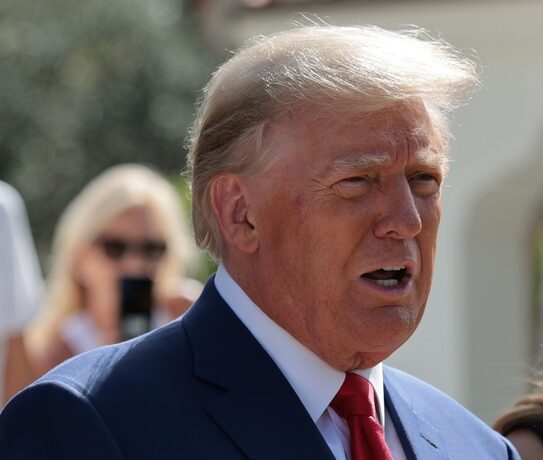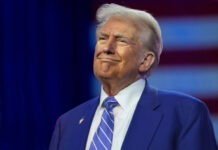A White House roundtable discussion on Wednesday, October 8, 2025, took an uncomfortable turn when President Donald Trump complimented a conservative commentator’s appearance after she claimed to have recovered from what MAGA supporters call “Trump Derangement Syndrome.” The 90-minute meeting, ostensibly focused on discussing Antifa as a domestic terrorist threat, quickly devolved into what critics described as a bizarre display of partisan flattery and attacks on mainstream media.
Brandi Kruse, a 37-year-old former mainstream television journalist turned conservative podcaster who hosts “unDivided with Brandi Kruse,” told the 79-year-old president she represented living proof that people could overcome their negative views of him. Kruse explained she had suffered from strong opposition to Trump for approximately eight years but claimed her recovery left her happier, healthier, and more successful.
“I even think I got a little more attractive after I got rid of my Trump derangement,” Kruse told the president, prompting laughter in the room and drawing Trump’s immediate response of “Very attractive.” The president later added that he felt very good about her no longer having what his supporters derogatorily term Trump Derangement Syndrome, a phrase used to mock liberals’ critical reactions to his policies and behavior.
The exchange rapidly went viral on social media platforms, with former MSNBC host Mehdi Hasan writing that he was glad he hadn’t eaten lunch or he would have thrown up. Other commentators characterized the moment as perfect material for “Saturday Night Live” sketches, with critics calling it embarrassing evidence that the MAGA movement operates like a cult. Some observers noted the interaction highlighted an ongoing pattern of inappropriate comments Trump has made toward women throughout his political career.
The roundtable began in typical fashion for Trump’s cabinet meetings, with Attorney General Pam Bondi, FBI Director Kash Patel, and Homeland Security Secretary Kristi Noem praising the president’s efforts to dismantle what they characterized as radical left-wing networks. Trump then invited conservative influencers and commentators who had been covering protests in Portland to share their experiences with Antifa, the loosely organized anti-fascist movement his administration designated as a terrorist organization in September.
Independent journalist Katie Daviscourt recounted being injured during a protest at a Portland ICE facility, stating she was sitting at the meeting with a black eye and concussion after being violently struck in the face with a pole while reporting just over a week before. She claimed that black-clad anarchist militants, concealing their faces behind coverings, have been assaulting reporters simply for covering their activities.
Jonathan Choe, who described himself as an investigative reporter for Frontlines Turning Point USA and senior fellow at the Discovery Institute in Seattle, urged the administration to examine Antifa’s alleged connections to the homeless crisis. He claimed without presenting evidence that Antifa members are heavily embedded in the homeless and housing nonprofit sector.
Kruse directed sharp criticism at White House correspondents present in the room, stating she could not care less what any of them had to say about the meeting. She insisted she was not there to convince mainstream media that Antifa represents a real threat, suggesting reporters who hadn’t reached that conclusion by now would never do so because they don’t want to see it.
The meeting grew increasingly contentious as Trump referred to the White House press corps as “the garbage standing over here” and polled his MAGA guests about which mainstream television networks they considered the worst. Independent journalist Nick Sortor, who was arrested during a demonstration at the ICE building in Portland, produced an American flag he claimed protesters had burned in Portland. Trump asked him to give it to Attorney General Bondi so the protesters who burned it could be prosecuted.
Despite the discussions and allegations presented, no evidence of an organized Antifa group traveling between Portland and Seattle emerged at the roundtable. Law enforcement authorities have consistently noted that Antifa lacks a detailed organizational structure or centralized leadership, making it fundamentally different from traditional terrorist organizations with hierarchical command structures.
The roundtable occurred amid escalating tensions over Trump’s push to deploy military forces to quell violence in Democratic-controlled cities as part of his crackdown on crime and support for mass deportation strategies. A federal judge in Portland temporarily blocked his plan to send troops into the city after determining no violent insurgency existed to justify such action. In Chicago, hundreds of National Guard members from Texas and Illinois were being deployed ahead of a court hearing where state leaders hoped to prevent the president from deploying federal forces.
Trump indicated earlier in the week that he would consider invoking the Insurrection Act of 1807 if necessary, a federal law permitting the president to deploy military forces to address what he deems an insurrection against the United States. He told reporters that if people were being killed and courts or local officials were impeding his efforts, he would not hesitate to enact the measure.











